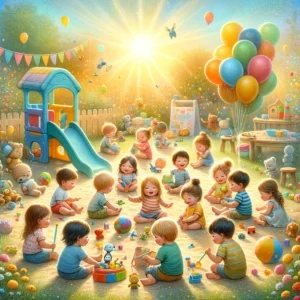Choosing the right toys for children is more than just about keeping them entertained. It’s about fostering their cognitive and physical development at various stages of their growth. In this article, we delve into the importance of selecting appropriate toys, provide tips for parents and caregivers, explore the history of children’s toys, and compare old and new toys in terms of their educational value.
The Importance of Selective Toy Choice
Toys are instrumental in promoting children’s learning and development. They can enhance cognitive abilities, such as problem-solving skills, memory, and concentration. Physically, toys encourage motor skills development, coordination, and strength. Socially and emotionally, they offer opportunities for children to interact with others, express themselves, and understand the world around them.
Tips for Choosing Developmental Toys
- Age Appropriateness: Select toys that match the child’s developmental stage. Toys should challenge them slightly but not be so difficult that they cause frustration.
- Safety First: Always consider the safety of toys. Look for non-toxic materials, and avoid small parts for young children who might swallow them.
- Encourage Creativity: Choose toys that encourage imaginative play, allowing children to explore and express themselves creatively.
- Physical Activity: Opt for toys that promote physical activity, especially for toddlers and older children, to help develop their motor skills and encourage a healthy lifestyle.
- Interactive and Social Play: Toys that encourage interaction can help develop social skills and emotional intelligence.
A Brief History of Toys
The history of toys is a fascinating journey that reflects the cultural, social, and technological shifts across different eras and societies. Toys, in their myriad forms, have always been a fundamental part of childhood, serving not just as tools for entertainment but also as instruments for education, socialization, and imagination. Let’s delve deeper into the evolution of toys through the ages, highlighting key developments and their impacts on children and society.
Prehistoric and Ancient Toys
The earliest toys discovered by archaeologists were made from natural materials like wood, stone, clay, and bone. These simple objects, such as miniature figures, balls, and animal-shaped toys, were not only playthings but also carried educational and religious significances in some cultures. For instance, in ancient Egypt, toys were believed to prepare children for their adult roles in society, while in ancient Greece, miniature chariots and dolls were common, reflecting the societal values and daily life of those times.
Medieval and Renaissance Toys
During the Medieval period, toys became more varied with the introduction of dolls, toy soldiers, and miniature replicas of tools and household items. These toys were often handmade and passed down through generations, embodying the craftsmanship and materials available in different regions. The Renaissance era saw the emergence of educational toys designed to teach arithmetic, astronomy, and geography, reflecting the period’s heightened interest in learning and discovery.
Industrial Revolution: The Democratization of Toys
The Industrial Revolution marked a pivotal moment in the history of toys. The advent of mass production made toys more affordable and accessible to families beyond the aristocracy. This era introduced classic toys such as rocking horses, tin soldiers, and train sets. The increased availability of materials like tin, rubber, and later, plastic, revolutionized toy manufacturing, leading to a wider variety of toys that could be produced at lower costs.
20th Century: The Golden Age of Toys
The 20th century is often regarded as the golden age of toys, with the invention of many iconic toys that are still loved today. The introduction of Teddy Bears in the early 1900s, Lego bricks in the 1950s, and Barbie dolls in the 1959, marked significant milestones. This period also saw the rise of board games like Monopoly as a popular form of family entertainment. The latter half of the century was characterized by the rise of electronic toys and video games, starting with simple handheld devices and evolving into sophisticated gaming consoles.
The Digital Age and Beyond
The late 20th and early 21st centuries have been defined by rapid technological advancements, leading to the advent of digital and interactive toys. These include educational computer games, virtual reality sets, and drones. Despite concerns over screen time, these modern toys offer new ways for children to learn and engage with the world. They also reflect the digital nature of contemporary life, preparing children for a future where technology plays a significant role.
Moreover, there’s been a growing appreciation for sustainable and eco-friendly toys, mirroring wider societal concerns about environmental issues. This has led to a resurgence in popularity of traditional wooden toys and the introduction of toys made from recycled materials.
The evolution of toys from simple, handmade objects to sophisticated digital devices tells a broader story about human development, technological progress, and cultural values. Toys not only entertain but also educate, reflect, and influence the societies in which they are created. As we move forward, the history of toys will continue to evolve, mirroring changes in technology, society, and how we understand and value childhood.
Learning Through Play: Old vs. New Toys
Old Toys: Traditional toys, such as wooden blocks, dolls, and board games, have stood the test of time for a reason. They require imagination and physical interaction, which are crucial for cognitive and physical development. For example, simple wooden puzzles and building blocks encourage problem-solving skills and fine motor skills.
New Toys: Modern toys, including educational apps and electronic gadgets, offer interactive and personalised learning experiences. These can be beneficial in teaching specific skills, such as language learning or basic coding. However, it’s important to balance screen time with physical play to ensure well-rounded development.
Age-Specific Toy Recommendations
Selecting the right toys for children at different stages of their development is crucial for fostering their growth, learning, and enjoyment. Toys are not just tools for play; they are vital for the development of cognitive skills, physical abilities, emotional understanding, and social interaction.
The following guide offers tailored recommendations for toys that cater to the specific developmental needs and milestones of children from infancy through to their early school years. By choosing age-appropriate toys, you can ensure that playtime is both fun and enriching, helping your child to explore, learn, and grow in the best possible way.
0-12 Months: Sensory and Motor Development
- Mirrors: Safe, baby-proof mirrors encourage self-discovery and visual tracking.
- Teething Toys: Soft, safe chewables can provide comfort as babies begin teething.
- Musical Toys: Instruments like rattles or soft music players stimulate auditory senses and can soothe or engage babies.
- Tummy Time Mats: These encourage physical development and strengthen neck, shoulder, and arm muscles.
1-2 Years: Exploration and Movement
- Stacking and Nesting Toys: Enhance problem-solving skills and understanding of size and order.
- Ride-on Toys: These promote balance and coordination and prepare toddlers for walking and running.
- Shape Sorters: Improve hand-eye coordination and introduce the concept of matching.
- Simple Musical Instruments: Encourage an interest in music and rhythm, aiding in auditory development.
3-5 Years: Imagination and Social Skills
- Play Kitchens and Tool Sets: Stimulate imaginative play and can improve understanding of the world.
- Storybooks: With more complex narratives and illustrations to spark imagination and language skills.
- Interactive Electronic Toys: Tablets and educational apps designed for children can offer personalized learning experiences in moderation.
- Outdoor Play Equipment: Swings, slides, and sandboxes encourage physical activity and interaction with the environment.
6 Years and Up: Critical Thinking and Social Interaction
- Complex Construction Sets: Engage children in engineering concepts, patience, and focus.
- Science Kits: Experiments can spark an interest in science and teach the scientific method.
- Coding Toys: Introduce basic programming concepts, fostering logical thinking and problem-solving skills.
- Sports Equipment: Encourages physical activity, teamwork, and perseverance.
Additional Considerations
- Inclusivity: Choose toys that represent a diverse range of cultures, abilities, and family structures to encourage empathy and understanding from a young age.
- Sustainability: Opt for toys made from sustainable materials to teach children about environmental stewardship.
- Limit Screen Time: While digital toys can be educational, it’s crucial to balance screen time with physical play and interaction to promote a healthy lifestyle.
By selecting toys that are tailored to a child’s developmental stage, parents and caregivers can provide opportunities for growth, learning, and fun. It’s important to remember that each child is unique, and their interests and developmental pace may vary. Observant caregivers can choose toys that best meet the child’s current needs and future growth, ensuring a supportive environment for exploration and discovery.
Choosing the right toys for children’s cognitive and physical development is a thoughtful process that requires considering the child’s age, interests, and the educational value of the toys. By providing a mix of traditional and modern toys, parents and caregivers can ensure a balanced approach to developmental learning through play. Remember, the ultimate goal is to foster a love of learning, creativity, and healthy development in all areas of life.








